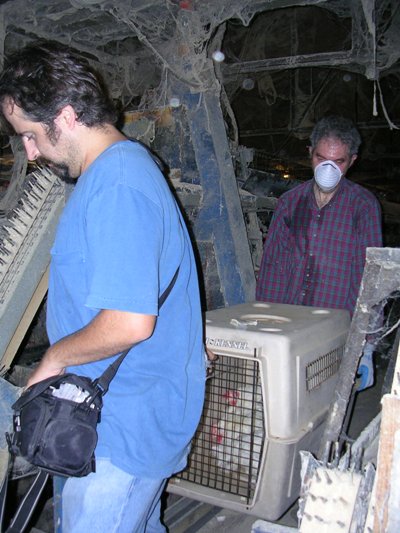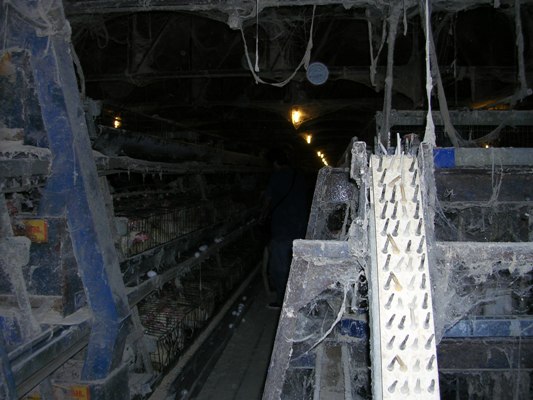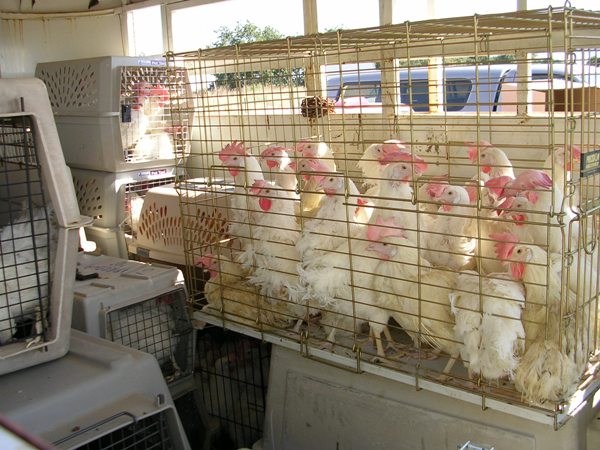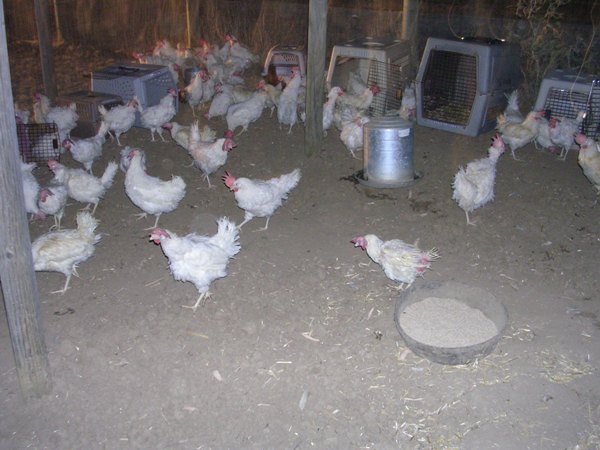From the Open-Publishing Calendar
From the Open-Publishing Newswire
Indybay Feature
Local Sanctuaries Rescue Hundreds of Hens from Slaughter
Animal Place and CAPE lead the effort to rescue and locate homes for 700 hens from an egg farm in California’s Central Valley.

It began with a phone call from PETA’s Bruce Friedrich. An egg farmer in California’s Central Valley had 160,000 “spent” hens he was about to send to slaughter. In other words, they’d been exploited to the point where their eggs were no longer valuable, so, after less than two years of life, it was time to move them out. Since he’d only get a penny each for them (they’d end up as dog and cat food), the farmer had told PETA they could take as many as they wanted. Bruce immediately contacted Kim Sturla of Animal Place (http://www.animalplace.org) in Vacaville. Kim got in touch with the farmer, whom she’d met previously, and coordinated Sunday, August 14, as the day she could come down and save as many chickens as possible. Kim called me on Friday, asking if I could contact the media. I told her I would see what publicity we could garner on short notice, and volunteered my help in rescuing the hens.
We left Animal Place on Sunday morning. Kim and Moncho Camblor, an Animal Place volunteer fluent in Spanish, drove down with a stock trailer, while I followed in my pickup truck with Christine Morrissey of East Bay Animal Advocates (http://www.eastbayanimaladvocates.org). I had spent part of Friday contacting news outlets, and I was pleased that a number of them, including television stations and newspapers, had agreed this was a worthwhile story; indeed, they were still calling Kim’s cell phone as we were en route to the farm. (The farmer had requested that the name and exact location of the farm not be divulged to the media.)
Kim had worked the phones throughout Friday and Saturday, setting up homes for the chickens, gathering volunteers and coordinating with the Marin Humane Society, which would be the adoption center. So, by the time we arrived there were already several volunteers from CAPE – the Center for Animal Protection and Education (http://www.capeanimals.org). There was some mild confusion at the farm as the Spanish-speaking workers tried to figure out what all these people were hoping to do, but after Moncho spoke with a couple of them, we began our work.
We each grabbed a plastic dog carrier and headed into an avian nightmare. I had been inside only one other factory farm – a broiler ranch – but it was practically a resort compared to this house of horrors. Inside a massive shed were row upon row of battery cages stacked three high, and within each cage were crammed eight to ten hens. It is impossible to convey in mere words the degree of filth, stench of ammonia, crowding and neglect these animals must endure. All natural light is shut out, and only some dim light bulbs illuminated the shed. Still, the massive cobwebs hanging above the chickens were clear enough, as were the bodies of birds left dead throughout the shed. Most consumers imagine that eggs come from bucolic farms where the chickens can wander outdoors and enjoy their lives. Nothing could be further from the truth. With razor-thin profit margins in animal agriculture, the majority of eggs and egg products are the result of mechanized processes and industrialized abuse. As is standard practice in this country, each battery cage at the farm was made completely of wire, so that waste dropped down onto the floor below the bottom cage. Consequently, hens on the top level looked relatively clean, hens on the middle level were spotted with excrement, and the unfortunate hens at the lowest level were among the saddest sights I’ve ever seen. With as many as twenty hens living above them, these poor creatures were entirely encrusted with waste material. They hadn’t the room to spread a single wing, let alone escape the constant barrage of feces and urine from above.
We worked in great haste, knowing we had only a few hours to save as many as we could. When we ran out of dog carriers, we cut ventilation holes in cardboard boxes and filled them with hens. Each time I had to climb the stairs back into that hell I reminded myself it was for the chickens. Yet I grew wearier with each step, knowing I had to choose from among many thousands of hens. Our actions decided who would live and who would be killed.
That’s not to say that all those we removed were assured a happy future. I was outside when Christine brought out two sick birds, and I helped her place them inside a large dog carrier in the shade. When I checked on them a few minutes later, they appeared lifeless. I could not bear the thought of these hens dying without knowing at least a tiny bit of kindness in their brief lives, so I filled a small container with bottled water and then carefully cradled each hen in turn and made sure she drank a little. One turned her head slightly to look up at me, her eyes adjusting to the unfamiliar light. I wept as I held them, and I weep for them still. I weep at the senseless pain they had to suffer, and I weep in shame at my membership in a species that visits this misery upon defenseless souls.
By 3:30 the farm hands were removing hens for slaughter, yanking them out of battery cages and stuffing them into even smaller wire crates, where they sat in stacks outside. Christine shot video and still pictures of this, images that will find their way onto the Internet soon. The frantic pace continued, with two groups working in the filthy darkness – one group pulling out birds for dog food, while another removed them for rescue. It was a grotesque lottery: slaughter or sanctuary. Late in the day two volunteers from an animal-rescue group in San Diego arrived with a moving van. Lorri Bauston had agreed to take in fifty hens at her new Los Angeles sanctuary Animal Acres (http://www.animalacres.org), and these two women were going to drop off the birds on their way back. CAPE also loaded their truck with hens destined for their sanctuary in Santa Cruz. In the end, we could not possibly remove them all, and we had to be satisfied with 700 or so hens – $7.00 worth of animals by the farmer’s reckoning.
Thankfully, the media waited well after dark for the rescued hens, and camera crews got footage of birds being offloaded and entering a temporary haven at Animal Place. I wandered the large pen with other volunteers, happy to see the hens enjoying their first taste of liberty, while sanctuary supervisor Varina Heilman, working with a flashlight, began the seemingly impossible task of trimming nails and checking the health of each bird.
We had promised to deliver twenty-five hens to the Marin Humane Society that evening, so I continued on to Novato with several boxes of birds. I pulled into the shelter after 11:00 p.m., but as exhausted as I was, I was euphoric as I carried the hens into a beautiful barn complete with a clean floor, fresh water and plenty of food. After spending their entire lives in cramped quarters, egg hens – or “layers,” as the industry refers to them – are bewildered by sudden freedom and large spaces. Many stayed huddled in their boxes, afraid to move. The shelter worker turned a box over and two hens lay motionless. “Are they dead?” he asked.
I watched their still bodies for signs of life, then bent down to stroke their feathers. “No,” I answered, “just scared.” Sure enough, they began to stir. “You’re going to be all right now, girls,” I said. “Enjoy.”
Anyone interested in adopting a hen may contact the Marin Humane Society at (415) 883-4621.
We left Animal Place on Sunday morning. Kim and Moncho Camblor, an Animal Place volunteer fluent in Spanish, drove down with a stock trailer, while I followed in my pickup truck with Christine Morrissey of East Bay Animal Advocates (http://www.eastbayanimaladvocates.org). I had spent part of Friday contacting news outlets, and I was pleased that a number of them, including television stations and newspapers, had agreed this was a worthwhile story; indeed, they were still calling Kim’s cell phone as we were en route to the farm. (The farmer had requested that the name and exact location of the farm not be divulged to the media.)
Kim had worked the phones throughout Friday and Saturday, setting up homes for the chickens, gathering volunteers and coordinating with the Marin Humane Society, which would be the adoption center. So, by the time we arrived there were already several volunteers from CAPE – the Center for Animal Protection and Education (http://www.capeanimals.org). There was some mild confusion at the farm as the Spanish-speaking workers tried to figure out what all these people were hoping to do, but after Moncho spoke with a couple of them, we began our work.
We each grabbed a plastic dog carrier and headed into an avian nightmare. I had been inside only one other factory farm – a broiler ranch – but it was practically a resort compared to this house of horrors. Inside a massive shed were row upon row of battery cages stacked three high, and within each cage were crammed eight to ten hens. It is impossible to convey in mere words the degree of filth, stench of ammonia, crowding and neglect these animals must endure. All natural light is shut out, and only some dim light bulbs illuminated the shed. Still, the massive cobwebs hanging above the chickens were clear enough, as were the bodies of birds left dead throughout the shed. Most consumers imagine that eggs come from bucolic farms where the chickens can wander outdoors and enjoy their lives. Nothing could be further from the truth. With razor-thin profit margins in animal agriculture, the majority of eggs and egg products are the result of mechanized processes and industrialized abuse. As is standard practice in this country, each battery cage at the farm was made completely of wire, so that waste dropped down onto the floor below the bottom cage. Consequently, hens on the top level looked relatively clean, hens on the middle level were spotted with excrement, and the unfortunate hens at the lowest level were among the saddest sights I’ve ever seen. With as many as twenty hens living above them, these poor creatures were entirely encrusted with waste material. They hadn’t the room to spread a single wing, let alone escape the constant barrage of feces and urine from above.
We worked in great haste, knowing we had only a few hours to save as many as we could. When we ran out of dog carriers, we cut ventilation holes in cardboard boxes and filled them with hens. Each time I had to climb the stairs back into that hell I reminded myself it was for the chickens. Yet I grew wearier with each step, knowing I had to choose from among many thousands of hens. Our actions decided who would live and who would be killed.
That’s not to say that all those we removed were assured a happy future. I was outside when Christine brought out two sick birds, and I helped her place them inside a large dog carrier in the shade. When I checked on them a few minutes later, they appeared lifeless. I could not bear the thought of these hens dying without knowing at least a tiny bit of kindness in their brief lives, so I filled a small container with bottled water and then carefully cradled each hen in turn and made sure she drank a little. One turned her head slightly to look up at me, her eyes adjusting to the unfamiliar light. I wept as I held them, and I weep for them still. I weep at the senseless pain they had to suffer, and I weep in shame at my membership in a species that visits this misery upon defenseless souls.
By 3:30 the farm hands were removing hens for slaughter, yanking them out of battery cages and stuffing them into even smaller wire crates, where they sat in stacks outside. Christine shot video and still pictures of this, images that will find their way onto the Internet soon. The frantic pace continued, with two groups working in the filthy darkness – one group pulling out birds for dog food, while another removed them for rescue. It was a grotesque lottery: slaughter or sanctuary. Late in the day two volunteers from an animal-rescue group in San Diego arrived with a moving van. Lorri Bauston had agreed to take in fifty hens at her new Los Angeles sanctuary Animal Acres (http://www.animalacres.org), and these two women were going to drop off the birds on their way back. CAPE also loaded their truck with hens destined for their sanctuary in Santa Cruz. In the end, we could not possibly remove them all, and we had to be satisfied with 700 or so hens – $7.00 worth of animals by the farmer’s reckoning.
Thankfully, the media waited well after dark for the rescued hens, and camera crews got footage of birds being offloaded and entering a temporary haven at Animal Place. I wandered the large pen with other volunteers, happy to see the hens enjoying their first taste of liberty, while sanctuary supervisor Varina Heilman, working with a flashlight, began the seemingly impossible task of trimming nails and checking the health of each bird.
We had promised to deliver twenty-five hens to the Marin Humane Society that evening, so I continued on to Novato with several boxes of birds. I pulled into the shelter after 11:00 p.m., but as exhausted as I was, I was euphoric as I carried the hens into a beautiful barn complete with a clean floor, fresh water and plenty of food. After spending their entire lives in cramped quarters, egg hens – or “layers,” as the industry refers to them – are bewildered by sudden freedom and large spaces. Many stayed huddled in their boxes, afraid to move. The shelter worker turned a box over and two hens lay motionless. “Are they dead?” he asked.
I watched their still bodies for signs of life, then bent down to stroke their feathers. “No,” I answered, “just scared.” Sure enough, they began to stir. “You’re going to be all right now, girls,” I said. “Enjoy.”
Anyone interested in adopting a hen may contact the Marin Humane Society at (415) 883-4621.
For more information:
http://www.animalplace.org
Add Your Comments
Latest Comments
Listed below are the latest comments about this post.
These comments are submitted anonymously by website visitors.
TITLE
AUTHOR
DATE
more press from earlier in the week
Fri, Aug 19, 2005 1:10PM
local press on chicken rescue
Fri, Aug 19, 2005 1:08PM
Chicken Biology
Tue, Aug 16, 2005 4:11AM
We are 100% volunteer and depend on your participation to sustain our efforts!
Get Involved
If you'd like to help with maintaining or developing the website, contact us.
Publish
Publish your stories and upcoming events on Indybay.
Topics
More
Search Indybay's Archives
Advanced Search
►
▼
IMC Network





